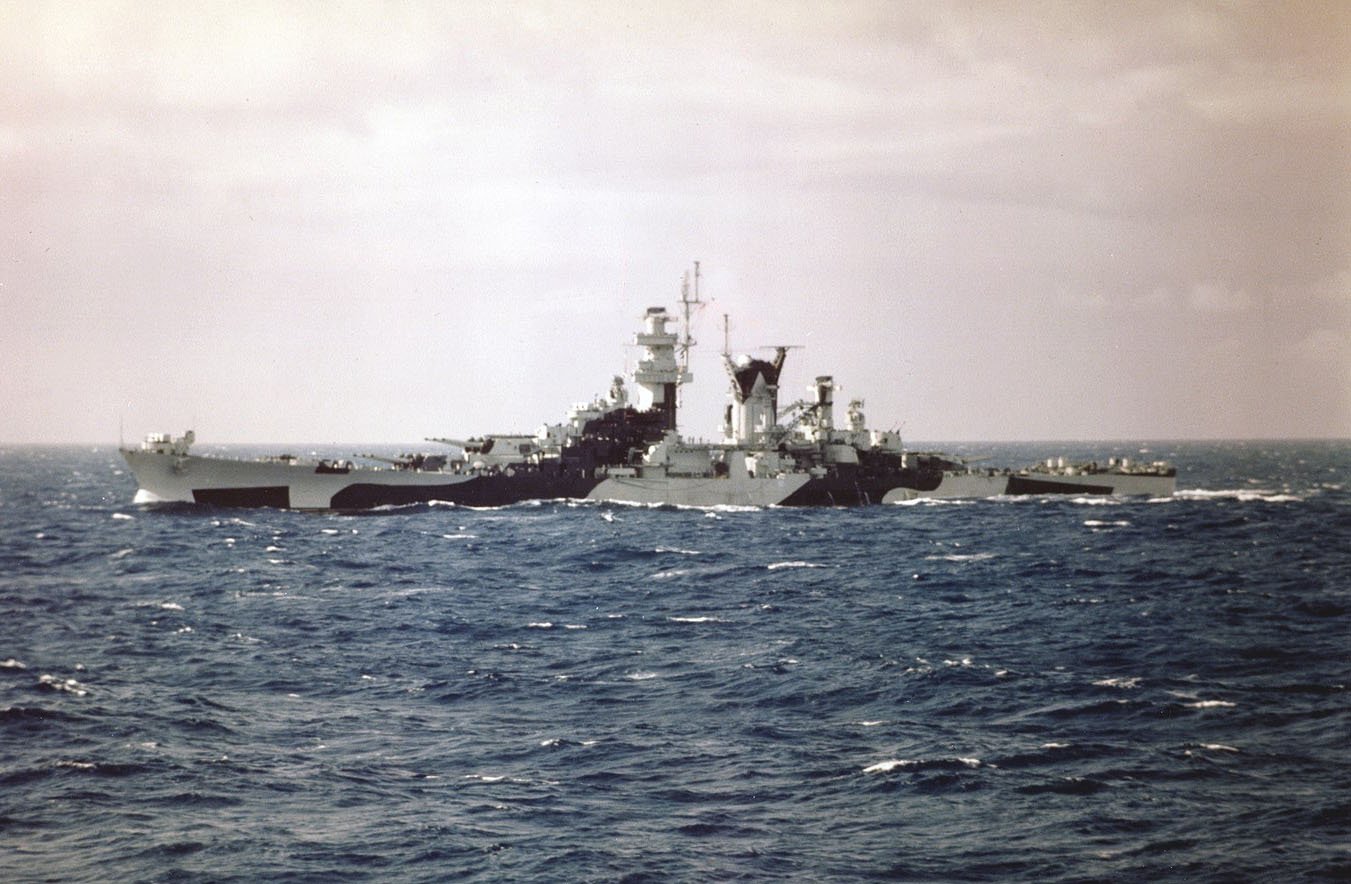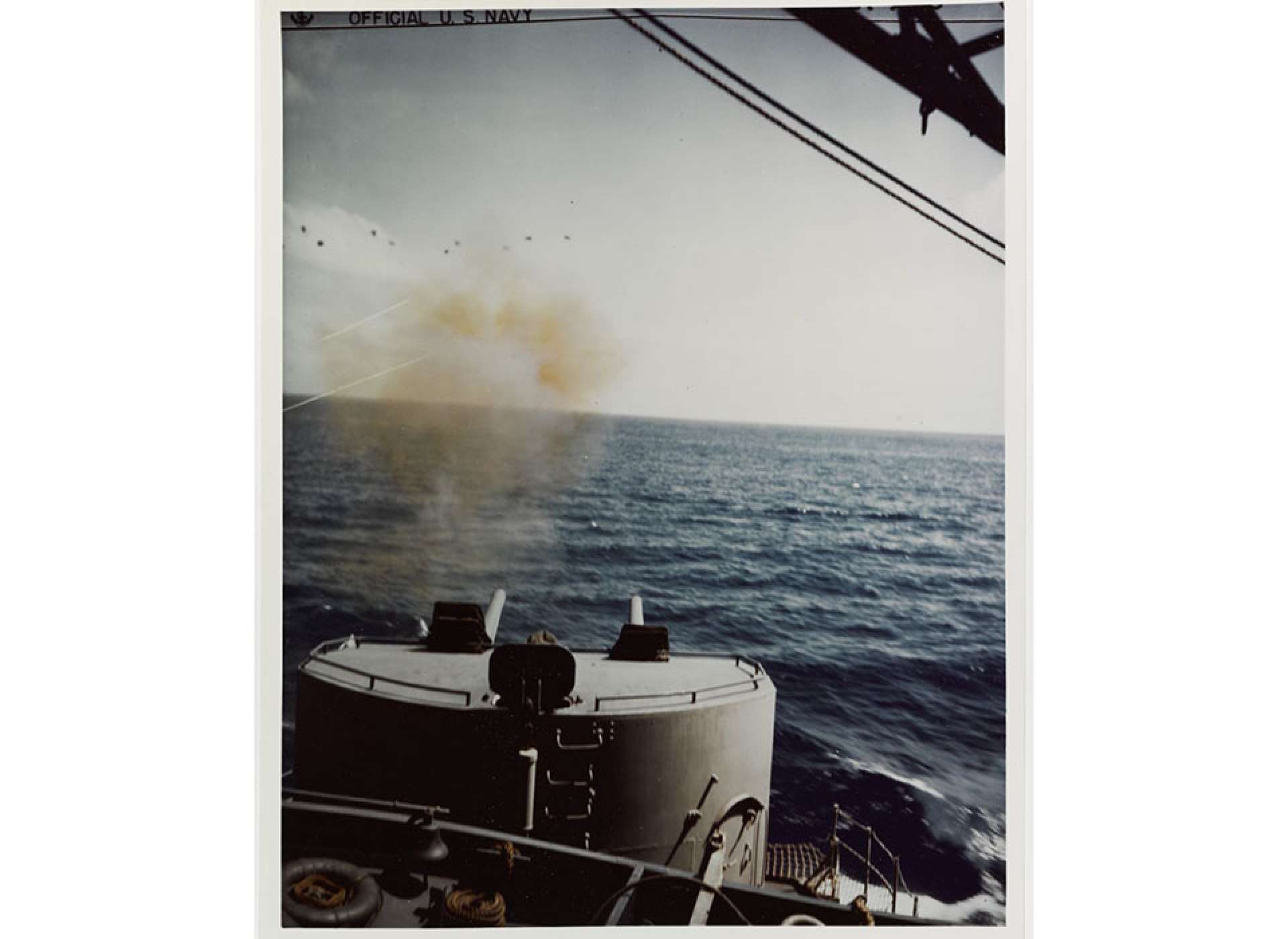Uss Alaska Cruiser - The USS Alaska was the lead ship of the Alaska class of large cruisers that served in the US Navy during World War II. She was the first of two ships of her class to be completed, followed only by Guam; four more ships were ordered but not completed until the end of the war. Alaska was the third ship of the US Navy to be named after the territory of Alaska and was assigned the hull number CB-1. She was laid down on 17 December 1941, t days after the United States ended the war, launched in August 1943 by the New York Shipbuilding Corporation at Camd, New Jersey, and commissioned in June 1944. She was armed with a main battery of nine 12- inch (300 mm) guns in three triple turrets and her top speed was 33 kn (61 km/h; 38 mph).
Because it was commissioned late in the war, service to Alaska was relatively limited. She participated in operations off Iwo Jima and Okinawa from February to July 1945, including providing anti-aircraft defense to various carrier task forces and conducting limited shore bombing. He shot down several Japanese planes near Okinawa, including a possible Ohka plane. In July-August 1945, he participated in the sweep of Japanese shipping in East China and the Yellow Sea. After the war ended, he assisted in the occupation of Korea and transported a group of US Army troops back to the US. She was decommissioned in February 1947 and placed in reserve, where she remained until scrapped in 1960 and sold for scrap the following year.
Uss Alaska Cruiser

Alaska had an overall length of 246.43 m (808 ft 6 in) and a beam of 27.76 m (91 ft 1 in) and a draft of 9.70 m (31 ft 10 in). She displaced a designed 29,779 long tons (30,257 t) and up to 34,253 long tons (34,803 t) at full load. The ship had a wavy bow and a rounded cruiser deck. She had a large superstructure that included an armored grinding turret with a tall turret mast, with a smaller secondary sling position aft.
Alaska Class Cruisers Asbestos Exposure
The ship was powered by four sets of Geral Electric geared steam turbines, each driving a screw propeller. Steam for the turbines was generated from eight oil-fired Babcock & Wilcox water tubes, directed through a large funnel located amidships. Propulsion system to produce 150,000 horsepower (110,000 kW), reaching a top speed of 33 knots (61 km/h; 38 mph). The ship had a range of 12,000 nautical miles (22,000 km; 14,000 mi) at a speed of 15 kn (28 km/h; 17 mph).
The ship was armed with a main battery of nine 12-inch (305 mm) L/50 Mark 8 guns in three triple gun turrets, two located forward and one aft of the superstructure.
The secondary battery consisted of twelve 5 in (127 mm) L/38 dual purpose guns in six twin turrets. Two of these were placed on the centerline with superfire over the main battery turrets, fore and aft, and the remaining four turrets were placed at the corners of the superstructure. The light anti-aircraft battery consisted of 56 square 40 mm (1.6 in) Bofors guns and 34 single 20 mm (0.79 in) Oerlikon guns.
A pair of Mk 34 gunners assisted the gun file of the main battery, two Mk 37 gunners manned the 5-inch guns and a Mk 57 manned the 40mm guns.
Large Cruiser Uss Alaska Cb 1
The main armor belt was 9 inches (229 mm) thick in the center of the hull, where it protected the propulsion machinery spaces and ammunition magazines, which were up to 5 inches d.l. The main armor deck was 4 inches (102 mm) thick. Her conning tower received 10.6 in (270 mm) armor plate on the sides. The gun turrets had a 12.8 in (325 mm) thick face.
On 17 December 1941 she was commissioned at the New York Shipbuilding Company in Camd, New Jersey. She was launched on August 15, 1943, sponsored by Dorothy Smith Gruing, wife of Alaska Governor Ernest Gruing, after which modifications were made. The ship was completed by June 1944 and commissioned by the US Navy on June 17 under the command of Captain Peter K. Fischler.
After her deployment, the Alaska steamed down to Hampton Roads, escorted by the destroyers Simpson and Broome. The ship is deployed on a cruise, first in the Chesapeake Bay and the Caribbean Sea, off Trinidad. She was accompanied on the voyage by the destroyers Bainbridge and Decatur. After the cruise ended, Alaska returned to the Philadelphia Navy Yard for some minor modifications, including the installation of four Mk 57 fire control directors on her 5-inch guns. On November 12, she left Philadelphia in the company of the destroyer-minesweeper Thomas E. Fraser, who was to conduct two weeks of tests near Guantánamo Bay, Cuba. On December 2nd, he left Cuba for the Pacific Ocean, two days later he passed through the Panama Canal and arrived in San Diego on December 12th. There her gun crews trained for shore bombardment and anti-aircraft fire.

On January 8, 1945, Alaska departed California for Hawaii and arrived at Pearl Harbor on January 13. There, he attended advanced training and was assigned to Task Force 12.2, which departed for Ulithi on January 29. The task force arrived in Ulithi on February 6 and was merged into Task Force 58.5, which is part of Task Force 58, or Fast Carrier Task Force. Task Force 58.5 was assigned to provide air defense of aircraft carriers; Alaska was assigned to the carriers Terprise and Saratoga. The fleet sailed for Japan on 10 February to conduct airstrikes against Tokyo and surrounding airfields. The Japanese did not attack the fleet during the operation. Alaska was transferred to Task Force 58.4 and assigned to support the assault on Iwo Jima. She served nine days off Iwo Jima before returning to Ulithi to refuel and resupply.
Alaska, Uss (cb 1)
Alaska remained on TG 58.4 for the Battle of Okinawa. He was tasked with identifying the carriers Yorktown and Intrepid; the fleet left Ulithi on 14 March and four days later reached its operating area southeast of Kyushu. That day, the first air attacks on Okinawa began, killing 17 Japanese aircraft on the ground. Here, Alaska finally saw battle as the Japanese launched a major air attack on the American fleet. His anti-aircraft guns destroyed a Yokosuka P1Y bomber that attempted to shoot down the Intrepid. Shortly thereafter, Alaska was notified that American aircraft were in the area. About t minutes later, his gunners spotted an unknown aircraft approaching menacingly; they shot down a Grumman F6F Hellcat fighter, although the pilot was not injured. Later that afternoon, Alaska was shot down by another Japanese bomber, a Yokosuka D4Y.
The next day, the carrier Franklin was heavily damaged by several bomb hits and kamikaze. Alaska and her sister Guam, two other cruisers, and several destroyers were detached to form Task Force 58.2.9 to escort the crippled Franklin back to Ulithi. On the voyage back to port, Franklin was attacked by another D4Y bomber, although the ships failed to shoot it down. Fire from one 5-inch gun accidentally caused a flash burn while standing several yards away; these were the only losses his crew suffered during the war. Alaska th assumed the role of fighter director; using his air search radar, he vectored fighters to intercept and destroy a Kawasaki Ki-45 heavy fighter. On 22 March the ships arrived at Ulithi and Alaska was detached to rejoin TG 58.4.
After returning to her unit, Alaska continued to search for aircraft carriers near Okinawa. On 27 March, she was detached to bombard Minamidaitō. She was joined by Guam, two light cruisers and a destroyer squadron on the night of the 47th against the 27th-28th. On the 1st of March, he fired forty-five 12-inch shells and three hundred and fifty-two 5-inch rounds at the island. The ships rejoined TG 58.4 at the replenishment point before returning to Okinawa to support the landings that began on 1 April. On the evening of April 11, Alaska shot down one Japanese plane, helped destroy another, and claimed it might have been a rocket-bomb piloted by Ohka. On April 16, the ship shot down three more aircraft and assisted three more. For the rest of the month, his heavy anti-aircraft fire succeeded in driving off the Japanese bombers.
Alaska returned to Ulithi to resupply and arrived on 14 May. He was assigned to the reorganized carrier task force TG 38.4. The fleet returned to Okinawa, where Alaska continued her anti-aircraft role. On June 9, she and Guam bombarded Oki Daitō. TG 38.4 steamed to San Pedro Bay in Leyte Gulf for rest and maintenance; the ship remained there from 13 June to 13 July, where she and her sister Guam were assigned to the cruiser Task Force 95 under the command of Rear Admiral Francis S. Low.
File:uss Alaska (cb 1) Off The Philadelphia Naval Shipyard On 30 July 1944 (nh 92282).jpg
Alaska and Guam on July 16
Uss alaska submarine, uss alaska model, uss cruiser, uss alaska battlecruiser, uss alaska, uss alaska ssbn, uss alaska ssbn 732, uss alaska cb 1, alaska cruiser, uss olympia cruiser, hobby boss uss alaska, uss chicago cruiser
0 Comments